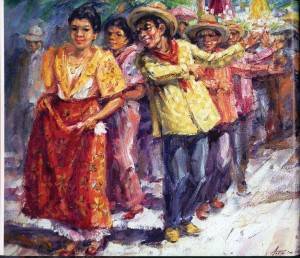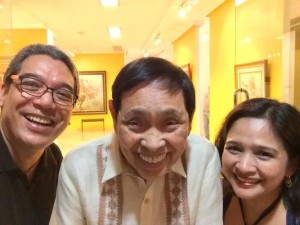
ANGEL C. Cacnio, the artist who designed and executed the P20 and P100 legal tenders showing Presidents Manuel Quezon and Manuel Roxas on a commission by the then Central Bank of the Philippines in the 1980s, is the subject of a mini retrospective of his six-decade-old art career at the gallery of the National Commission for Culture and the Arts (NCCA).

It is fitting that Cacnio’s art should be showcased in the halls of the country’s chief cultural agency. Here’s an artist who painted images and scenes that have become a veritable cultural iconography—the raising of the Philippine flag and the drawing-down of the United States flag in the old P100 bill (which riled nationalists who scoffed that a Philippine legal tender should show the American colors); the din and blare and energy of the sabungan (cockpit); the industry of small farmers and beasts of burden; and the grace and riot of colors of the Hispanic dances of Filipinos, and of the Ifugao and T’boli community dances.

The exhibit, “Angel of Art,” has a beautiful catalogue that pictorially surveys key representative works of Cacnio since the 1950s. It includes a helpful article on the artist by Jessica Jalandoni-Robillos that originally appeared in the Inquirer Arts and Books subsection. Delan Robillos, the vice head of the NCCA’s National Committee on Art Galleries, has helped curate the exhibit and explains in the catalogue introduction the achievement of Cacnio:

“Collectors and colleagues, old and young, are awed by the artist’s mastery of both oil and watercolor. Patrons and newbie followers of Philippine art are beguiled by his meticulous choice of colors, hues, and tones, revealing complexity, intricacy and intensity all at once. His obras are brimming with Filipino values, culture, heritage, tradition, life, resilience, hope.”
Folk roots
Born in Malabon on June 6, 1931, Cacnio grew up amid folk designs decorating old horse-drawn rigs and fishing banca. Cacnio likewise grew up enjoying the old komiks, especially those drawn by National Artist Francisco Coching. He went to the University of the Philippines school of fine arts where his classmates included Salvador Cabrera and National Artist Federico Aguilar Alcuaz. His mentor was Toribio Herrera.
He was one of the first winners of the Shell Awards: “Tatlong Sabungero,” which won first prize in 1953, made the sabong a Philippine art genre. Cockpit aficionados would later turn to Cacnio for his renditions of the game that have become a staple in Philippine art.
His stint in the Ramon Roces Publications consolidated his innate pictorial talent. And because it was the only way an artist could jump-start his art during those days when the art market was nascent, Cacnio joined national art contests that consolidated his reputation as one of the foremost artists of his day.
In 1964, he won the Apolinario Mabini Centennial Art Competition with his “Capture of Mabini.” His winning designs for 25- and 50-centavo joins were used by the Central Bank in the 1980s. He also won for his designs for the one-centavo coin (Lapu-Lapu) and the five-centavo coin (Tandang Sora).
Perhaps it reflects the sheer disjunction in contemporary Philippine arts and culture— and nation-building—that recent historical milestones, such as the 150th birth centennial of Mabini, even the monetization of new legal tenders, have not involved artists.
The new legal tenders released by the new Bangko Sentral ng Pilipinas (BSP) have undistinguished designs. Worse, their colors overlap so that the new bills confuse users who can hardly distinguish between the red of the new P20 bill and the red of the new P50 bill, and between the blue of the P100 and the blue of the P1,000. All this would have been avoided had the BSP consulted top artists and designers.
When the United Nations marked its 70th anniversary last year, part of the celebration was the rendering in blue (the UN color) of more than 70 international landmarks: While China was represented by the Great Wall, Egypt by the Great Pyramids, Italy by the Pisa Tower and Australia by the Sidney Opera, the Philippines was represented by the paltry globe of a giant shopping mall. No less than the foreign secretary, Alberto del Rosario, went to the mall to officially light up the globe.
‘Costumbrismo’
Cacnio combined both folk sensitivity and modern technique to innovate genres and create new ones. His “Unang Misa,” about the first Catholic Mass in the Philippines, departed from the very established rendition by Botong Francisco by dynamic colors and gestural verve. The same kinetic vigor characterizes his oil-on-canvas works of native dances.
To some extent, Cacnio was heir to the costumbrismo of the Philippines’ Hispanic heritage. Everyday local life is depicted, with special attention on social manners and customs. The sabong aficionados are depicted dressed in native garb, giving them a certain genteel character.
Nineteenth-century costumbrismo was related both to realism and romanticism, but in Cacnio’s—and several other Filipino artists’ —reformulation of the movement in the 20th century, the two styles melded and meshed so that what should be a style to represent Spanish heritage was utilized for social and anthropological investigation of the people’s indigenous heritage.
For example, typical costumbrista representation of Hispanic-based Filipino dances in their native costumes was applied to Ifugao and T’boli dances with dancers shown in very colorful costumes or in celebratory nudity.
Moreover, modern Filipino artists like Cacnio used realism and romanticism germane to costumbrismo in constituting an aesthetic dialectic that resulted in a new synthesis, providing an undercurrent of edginess to contemporary issues. This is shown, for instance, in “Reporma.”
Art such as Cacnio’s is attuned to the folk and the social. It is true to the roots of all great art—the rhythm of life of the people, the bonds that attach kinsmen and neighbors, the history of a people that is both personal and social. In contrast, contemporary art is self-absorbed and pathologically infantile, celebrating the toys, trivia and effluvia of global but banal popular culture.
Cacnio celebrated Hispanic-inspired Philippine dances, as well as the dances of the cultural communities; he celebrated the Filipino family and the heroism of Mabini and the small farmer. In contrast, the Department of Foreign Affairs celebrated the Filipino nation through the vapid shopping mall.
“Angel of Art” will run till Jan. 28 at the NCCA Gallery, NCCA Building, 633 General Luna Street, Intramuros, Manila; tel 5272192 loc. 308 or 5235382.

